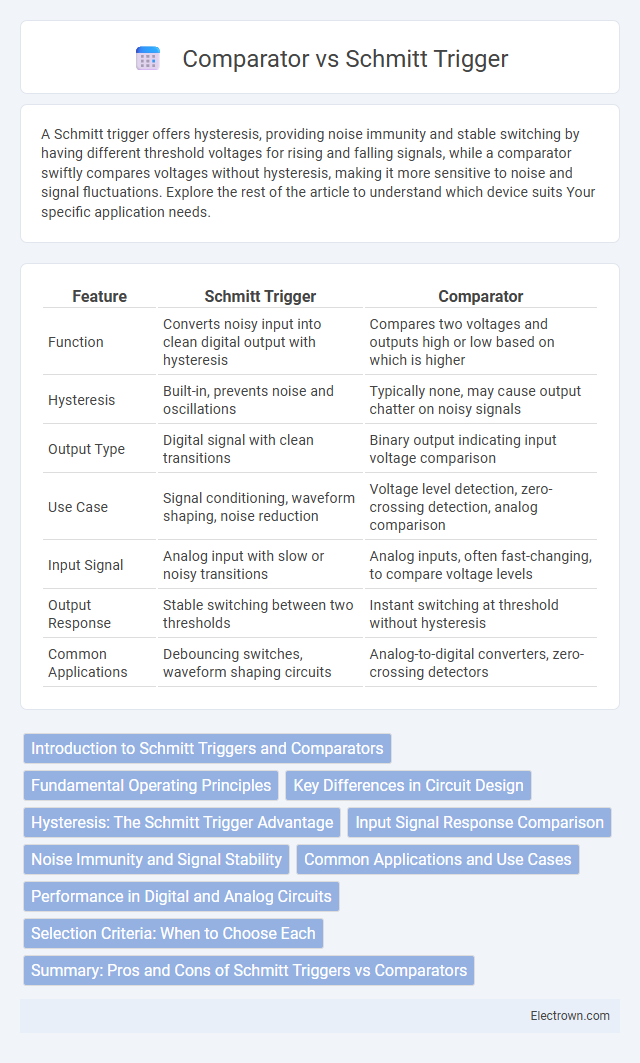A Schmitt trigger offers hysteresis, providing noise immunity and stable switching by having different threshold voltages for rising and falling signals, while a comparator swiftly compares voltages without hysteresis, making it more sensitive to noise and signal fluctuations. Explore the rest of the article to understand which device suits Your specific application needs.
Table of Comparison
| Feature | Schmitt Trigger | Comparator |
|---|---|---|
| Function | Converts noisy input into clean digital output with hysteresis | Compares two voltages and outputs high or low based on which is higher |
| Hysteresis | Built-in, prevents noise and oscillations | Typically none, may cause output chatter on noisy signals |
| Output Type | Digital signal with clean transitions | Binary output indicating input voltage comparison |
| Use Case | Signal conditioning, waveform shaping, noise reduction | Voltage level detection, zero-crossing detection, analog comparison |
| Input Signal | Analog input with slow or noisy transitions | Analog inputs, often fast-changing, to compare voltage levels |
| Output Response | Stable switching between two thresholds | Instant switching at threshold without hysteresis |
| Common Applications | Debouncing switches, waveform shaping circuits | Analog-to-digital converters, zero-crossing detectors |
Introduction to Schmitt Triggers and Comparators
Schmitt triggers and comparators are essential analog circuits used to process varying input signals. A Schmitt trigger features hysteresis to provide noise immunity and clean digital output transitions, making it ideal for signal conditioning in noisy environments. Comparators, by contrast, compare input voltages against a reference level and instantly switch their output, enabling precise threshold detection in applications such as ADCs and zero-crossing detectors.
Fundamental Operating Principles
A Schmitt trigger operates using hysteresis to provide a stable output by defining two distinct threshold voltage levels, which prevents noise-induced rapid switching common in comparator outputs. Comparators perform a straightforward voltage comparison, producing a high or low output depending solely on which input voltage is greater, without inherent noise filtering or hysteresis. The fundamental distinction lies in the Schmitt trigger's built-in positive feedback mechanism that creates practical noise immunity, whereas comparators rely purely on input voltage differences for switching.
Key Differences in Circuit Design
Schmitt trigger circuits feature hysteresis with two distinct threshold voltage levels, enabling noise immunity and stable output switching, while comparators have a single threshold with rapid output changes. The feedback mechanism in Schmitt triggers creates a regenerative effect, reducing output chatter in noisy environments, unlike comparators that rely solely on input signal comparison. Schmitt triggers often incorporate positive feedback in their design, whereas comparators typically lack feedback, focusing purely on voltage level detection.
Hysteresis: The Schmitt Trigger Advantage
The Schmitt trigger offers a distinct advantage over a standard comparator by incorporating hysteresis, which creates two different threshold voltages for rising and falling signals. This hysteresis prevents noise-induced false triggering and ensures stable output transitions, especially in noisy or slow-changing input environments. Comparators lack this built-in hysteresis, making Schmitt triggers ideal for signal conditioning tasks requiring clean, noise-immune switching.
Input Signal Response Comparison
A Schmitt trigger features hysteresis that provides distinct upper and lower threshold voltages, enabling it to cleanly switch output states in response to noisy or slowly varying input signals by rejecting small fluctuations. In contrast, a comparator switches its output whenever the input crosses a single threshold voltage, making it more sensitive to noise and prone to output oscillation near the switching point. This difference in input signal response makes the Schmitt trigger ideal for transforming noisy or analog input signals into stable digital outputs, while comparators are better suited for precise threshold detection without hysteresis.
Noise Immunity and Signal Stability
A Schmitt trigger excels in noise immunity due to its hysteresis characteristic, which creates distinct upper and lower threshold voltages, effectively filtering out small fluctuations and preventing rapid toggling of the output. In contrast, a comparator without hysteresis is highly sensitive to noise near the threshold, often resulting in unstable, noisy output signals. Consequently, Schmitt triggers provide superior signal stability in noisy environments, making them ideal for clean switching applications.
Common Applications and Use Cases
Schmitt triggers are commonly used in signal conditioning to convert noisy or analog input signals into clean digital outputs, making them ideal for debouncing switches and shaping waveform signals in microcontroller interfaces. Comparators are extensively utilized in analog-to-digital conversion, zero-crossing detectors, and voltage level detection circuits where precise threshold detection and high-speed switching are critical. Both devices are essential in control systems, with Schmitt triggers enhancing noise immunity and comparators offering exact threshold comparison for real-time decision-making.
Performance in Digital and Analog Circuits
Schmitt triggers deliver superior noise immunity and hysteresis, making them ideal for digital circuits where clean transitions are essential to prevent false triggering. Comparators excel in analog circuits by providing precise threshold detection without hysteresis, allowing for accurate signal level monitoring. Your choice between these components depends on whether you prioritize stable digital switching or sensitive analog voltage comparison.
Selection Criteria: When to Choose Each
Choose a Schmitt trigger when signal stability is critical, as its hysteresis property effectively filters noise and prevents output oscillations in slowly varying input signals. Opt for a comparator if you require fast, precise threshold detection with minimal delay in clean, high-speed applications. Your decision should weigh input signal characteristics and noise tolerance to ensure optimal performance in your circuit design.
Summary: Pros and Cons of Schmitt Triggers vs Comparators
Schmitt triggers provide noise immunity and hysteresis, making them ideal for clean digital switching in noisy environments but may have slower response times compared to comparators. Comparators offer fast, precise threshold detection with higher speed and sensitivity, yet they can be prone to noise-induced false triggering without added hysteresis. Choosing between the two depends on application needs: Schmitt triggers excel in stable digital signal processing, while comparators are suited for high-speed analog signal detection.
Schmitt trigger vs comparator Infographic

 electrown.com
electrown.com